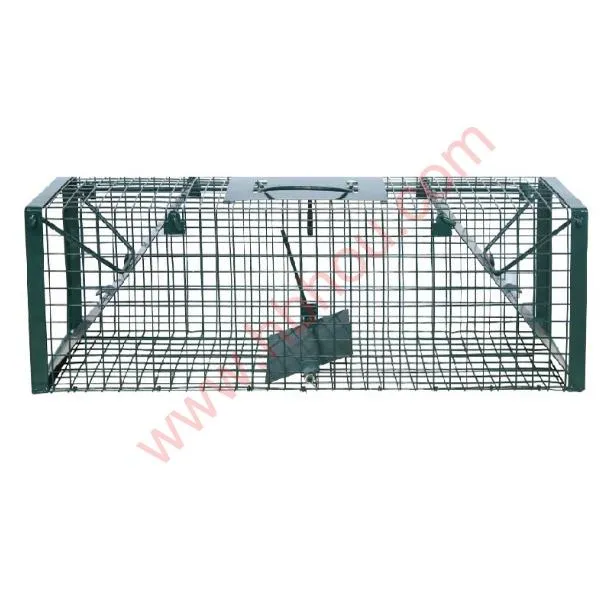When dealing with wildlife around your property, using the right wildlife trap is essential for effective and humane animal control. Whether you're trying to capture a raccoon, squirrel, or other critters, selecting the proper wild animal trap can help safely remove these animals from your space without causing harm. In this guide, we'll cover the different types of wild traps available for sale, important factors to consider when purchasing them, and tips for successful trapping.

Types of Wildlife Traps
Live Animal Traps
Live animal traps are designed to capture animals without injuring them. These humane traps feature a bait compartment and a trigger mechanism that closes the door once the animal enters. They are ideal for catching animals like raccoons, squirrels, rabbits, and other small mammals. Common materials include galvanized steel for durability and rust resistance.
Cage Traps
Cage traps are the most common type of wild animal traps and are available in various sizes to accommodate different species. They allow you to safely relocate the animal after capture. Some models come with double doors for increased success rates, as they allow animals to enter from either direction.
Foot-hold Traps
These traps are used mainly for trapping larger wild animals such as coyotes and bobcats. They capture the animal by clamping down on the leg, holding it in place without causing major injury. This type of trap is generally used by professional trappers and requires skill to operate humanely.
Body-grip Traps
Body-grip traps, also known as conibear traps, are used for catching medium-sized animals like beavers or muskrats. These traps are designed to kill the animal quickly and humanely by applying pressure to the neck or chest. They should only be used in situations where lethal control is necessary and legal.
Snare Traps
Snare traps consist of a loop of wire or cable that tightens around an animal when it passes through the loop. Snares are generally used for trapping wild animals like foxes or rabbits. Snares can either be lethal or non-lethal, depending on the design and intent of use.
Factors to Consider When Purchasing Wildlife Traps
Size and Species
Choosing the right trap size is critical. A trap that's too small may harm the animal or result in failure, while a trap that’s too large may allow the animal to escape. Ensure that the trap is suitable for the species you're targeting, whether it's a raccoon, opossum, or squirrel.
Durability
Wildlife traps need to be strong and durable, especially when dealing with larger, more aggressive animals. Traps made from heavy-duty materials like galvanized steel are resistant to rust and corrosion, ensuring they last through repeated use and exposure to the elements.
Ease of Use
Look for wildlife traps that are easy to set up and operate, especially if you're new to trapping. Many traps come with step-by-step instructions and even bait recommendations. Traps with sensitive triggers are ideal for smaller animals, while more robust models are better suited for larger wildlife.
Legal Considerations
Before purchasing or setting up any wild animal trap, it’s important to check your local regulations regarding wildlife trapping. Some areas have strict rules on what types of traps can be used, how they can be deployed, and which animals can be captured.
Humane Options
When possible, it's best to use humane traps that capture the animal alive, allowing for safe relocation. Look for traps that minimize harm to the animal, such as smooth metal surfaces and secure locking mechanisms.
Tips for Successful Wildlife Trapping
Use the Right Bait: Different animals are attracted to different types of bait. For example, raccoons respond well to sweet-smelling foods like marshmallows, while squirrels prefer nuts and seeds. Understanding the preferences of your target animal will increase your trapping success.
Place Traps Strategically: Position your trap along animal pathways, near burrows, or in areas where you've noticed animal activity. Animals tend to follow the same routes, so placing the trap in these locations increases the likelihood of capture.
Check Traps Frequently: It's important to monitor traps regularly to ensure that captured animals are not left in the trap for extended periods. This is crucial for both ethical reasons and to comply with legal regulations.
Handle with Care: If you've captured an animal alive, wear gloves when handling the trap to protect yourself and the animal. After capture, release the animal in a safe and appropriate location, far from human habitations.
Wildlife control requires patience and the right tools. Whether you're dealing with pesky raccoons, squirrels, or larger animals like coyotes, choosing the right wildlife trap is key to resolving the problem effectively and humanely.
At our company, we offer a wide variety of wild animal traps for sale, designed for durability, ease of use, and humane capture. Whether you need a small cage trap for a squirrel or a heavy-duty trap for a raccoon, we have a solution that fits your needs. Browse our selection today and ensure you're prepared for your next wildlife challenge.
















